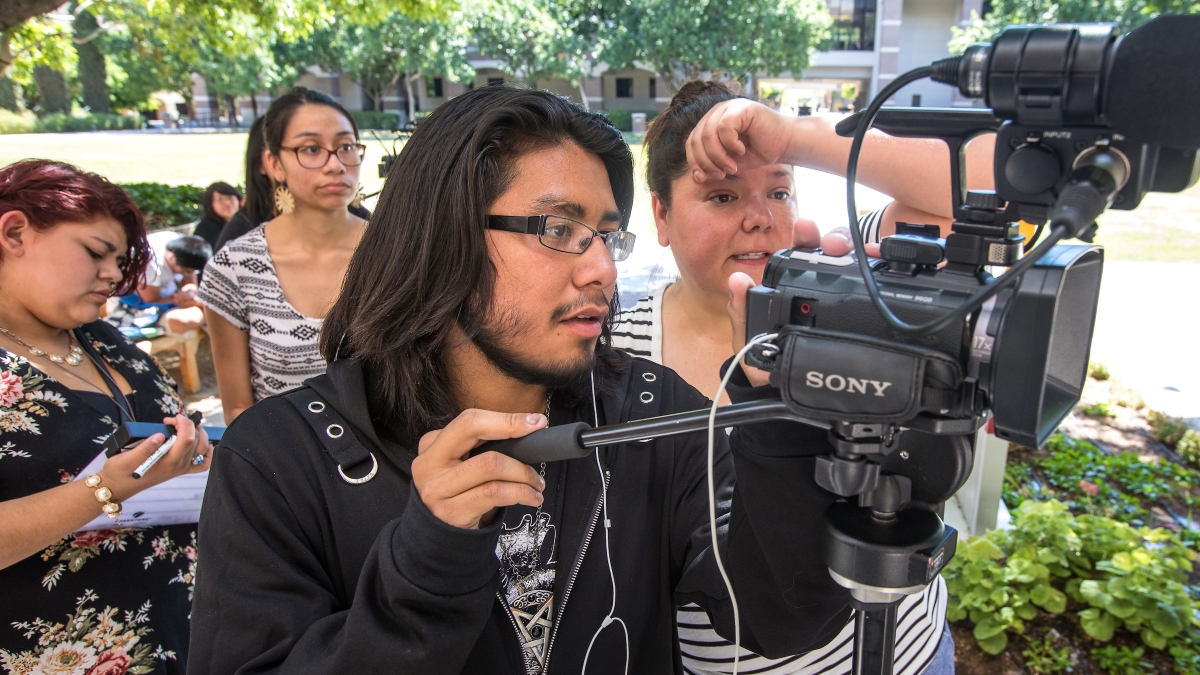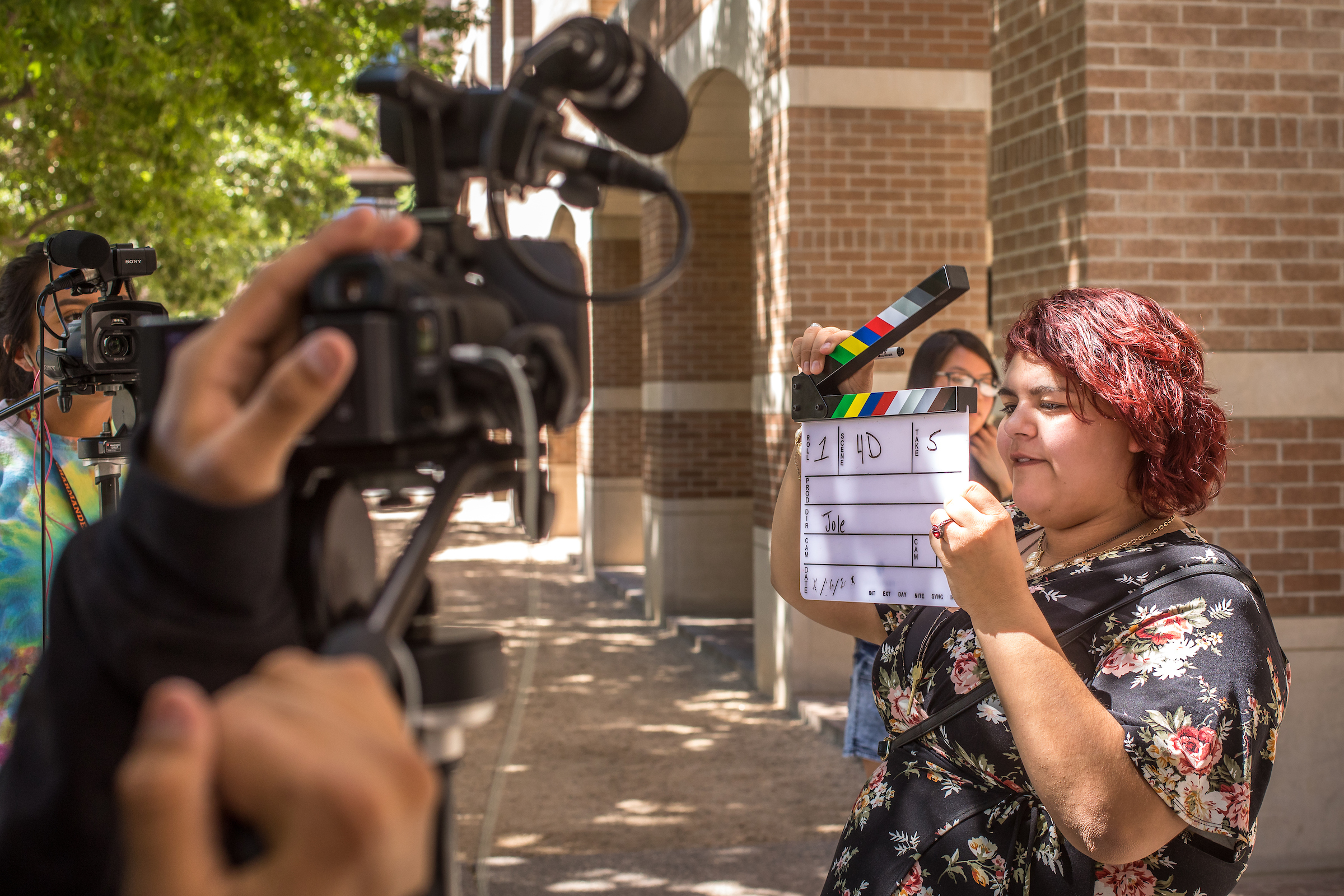Sally Kewayosh uses the short break in filming while students reposition their cameras to explain the 180-degree ruleThe 180-degree rule is a basic guideline regarding the on-screen spatial relationship between two characters within a scene. By keeping the camera on one side of an imaginary axis between the characters, the first character is always frame right of the second character. of cinematography, then instructs one of them to come in closer for a profile shot.
An accomplished filmmaker and a member of the Walpole Island First Nation, Kewayosh is on location at Arizona State University's West campus this week to share her knowledge with a group of high school students participating in the Native American Summer Arts Workshop (NASAW). She was invited by ASU Assistant Professor Jacob Meders, who is instructing the students in printmaking and drawing.
Meders, a member of the Mechoopda Indian Tribe of Chico Rancheria, California, attended a similar program in high school that inspired him to get his bachelor’s degree in fine arts at Savannah College of Art and Design and, later, his master’s in printmaking at ASU. So when Patrick BixbyBixby is also an associate professor of English at ASU., director of International Tribal Initiatives at ASU's New College of Interdisciplinary Arts and Sciences, asked for his help organizing NASAW, he was all in.
“Coming from the family background that I came from, there was no one to really to guide me after I saw all the cool art stuff you could do in college,” said Meders, who is the founder of WarBird Press studio in Phoenix. “It wasn’t until I got older that I kind of figured it out on my own.”
An immersive, weeklong experience in which students live on campus and are encouraged to explore the university’s offerings, the arts workshop is just one of several outreach programs at ASU that are geared toward giving young Native American students an early taste of the college experience.
One week before NASAW kicked off, 50 Native American high school students taking part in the INSPIRE camp on the Tempe campus observed a mock trial, learned how to build a resume, toured the Walter Cronkite School of Journalism and Mass Communication building on the Downtown Phoenix campus and attended a resource fair.
“This year’s INSPIRE summer program provides an unique opportunity for American Indian high school students to learn more about academic major options and potential careers from the five major themes implemented: power and place; leadership; college and career; closer look at ASU; and community partnerships,” said Annabell Bowen, director of American Indian Initiatives.
Native American students make up less than 1 percent of all college students in the U.S., and only about 13 percent of all Native American people have a college degree. Recognizing a need, ASU has created a number of college-preparedness programs aimed at Native American students. In addition to NASAW and INSPIRE, they include the daylong RECHARGE conference, featuring guest speakers and conversations on topics ranging from financial aid to wellness and careers; the SPIRIT orientation initiative, which helps Native American students adjust to college life over a two-week period; and the Tribal Nations Tour, which brings ASU to schools with high populations of American Indian students throughout the state.
Group chaperone Red Gastelo, of Phoenix College, sets the clapper to start a scene as the class makes a four-minute video as part of the Native American Summer Art Workshop on the West campus on June 27.
The programs’ reaches are expanding beyond Arizona, though — a few of the students attending NASAW at ASU West came all the way from California. Mikail Morgan, who attends Sherman Indian High School in Riverside, said not many colleges where she lives have programs that speak specifically to Native American students.
On Wednesday, she played one of the characters in a series of three student-filmed stories that will be showcased Friday at 7 p.m. at Art Space WestArt Space West is located on the north side of the University Center Building on ASU’s West campus. in a free and open-to-the-public exhibition of their work.
Later Wednesday afternoon, Morgan and the rest of the NASAW cohort enjoyed a special tour of the Heard Museum, one of the program’s sponsors, who also hosted them for dinner that evening. Other sponsors include the Phoenix Indian Center, the Labriola Center, the Herberger Institute for Design and the Arts and the Arizona Commission for the Arts, which also provided funding.
In the future, Bixby hopes to see the program expand to other fields of study at New College, such as its flagship forensics program. For now, he and Meders are thankful to have gotten it off to a promising start.
“Everybody in the community, Native and non-Native, has really pitched in, and it’s just awesome to see the support,” Meders said. “It’s been pretty wild to see these students working so hard. … It’s obvious to us that they all have the potential to make it in college, and to excel in college. So this is great way for them to see it in themselves.”
Top photo: Instructor Sally Kewayosh looks at the screen of Patrick House, 16, of Saw Mill, Arizona, as they prepare to shoot a scene for their four-minute video as part of the Native American Summer Art Workshop on the West campus on June 27. Kewayosh is a filmmaker with Achimowin Films in Albuquerque. Photo by Charlie Leight/ASU Now
More Arts, humanities and education

ASU professor's project helps students learn complex topics
One of Arizona State University’s top professors is using her signature research project to improve how college students learn science, technology, engineering, math and medicine.Micki Chi, who is a…

Award-winning playwright shares her scriptwriting process with ASU students
Actions speak louder than words. That’s why award-winning playwright Y York is workshopping her latest play, "Becoming Awesome," with actors at Arizona State University this week. “I want…

Exceeding great expectations in downtown Mesa
Anyone visiting downtown Mesa over the past couple of years has a lot to rave about: The bevy of restaurants, unique local shops, entertainment venues and inviting spaces that beg for attention from…



